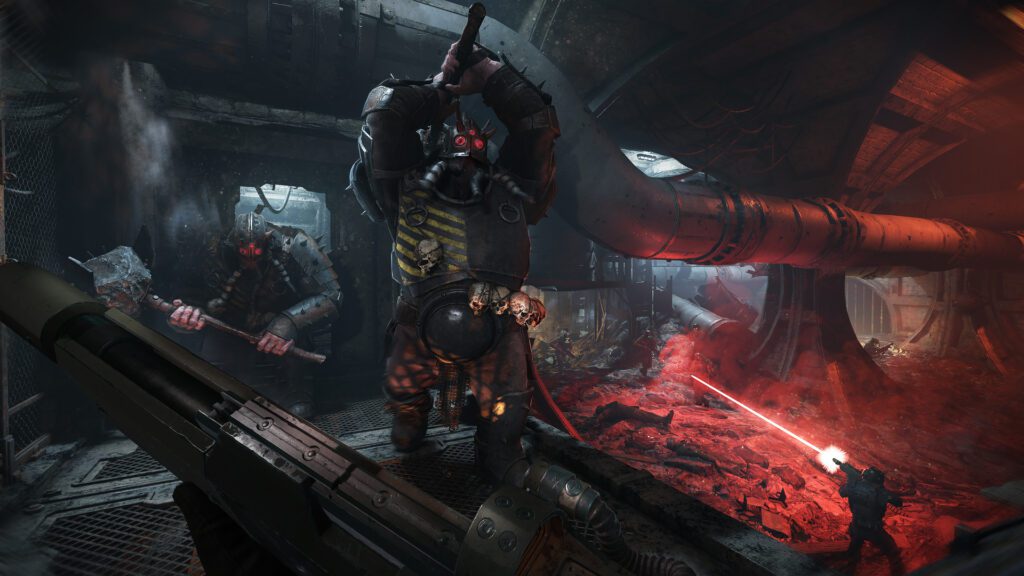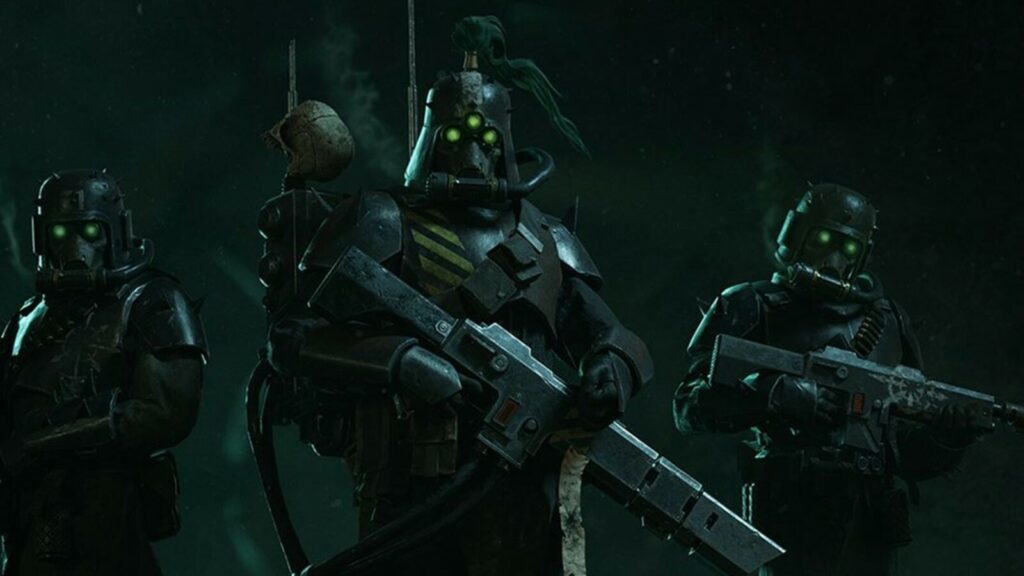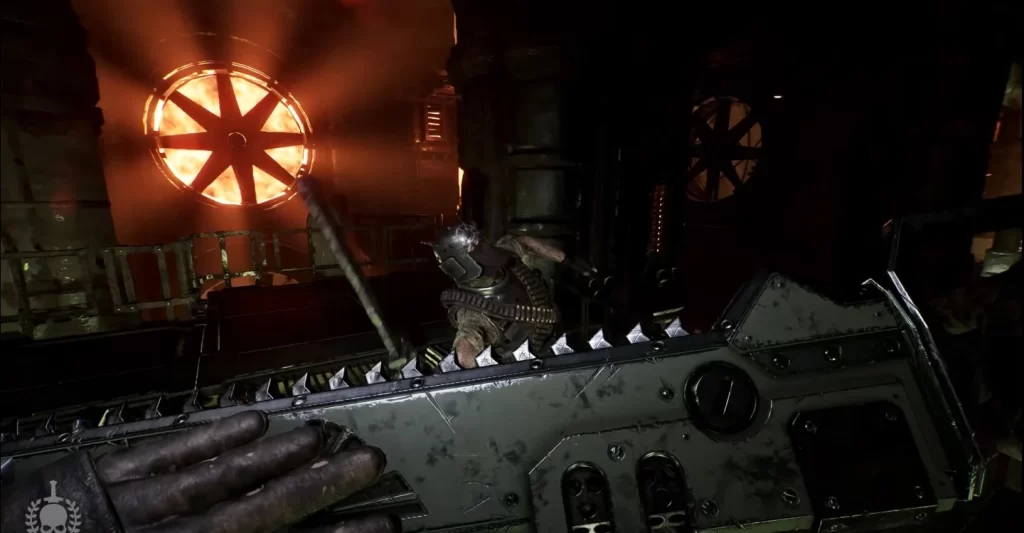Darktide is not simply a Left 4 Dead-like. It’s also the spiritual successor to Fatshark’s previous series in the genre, Vermintide. Moving the experience out of the base Warhammer world and into the remote and grimdark future of Warhammer 40K includes a significant transformation both cosmetically and mechanically. The most excellent brand-new addition comes in the type of arsenal of guns that have no place in the brutal fantasy of conventional Warhammer. But in the 40K era, things like hand cannons, assault rifles, and electricity-infused projectiles fit right in and drastically altered the circulation of battle by including more range-based considerations.
This colossal shift is well-implemented, as enemies will match you blow for blow. Combating from a range will see them trading shots and taking cover, and if you– or they– can close the gap, they’ll rapidly swap to melee battle. When this occurs, Darktide leans into the still-great crowd-control components, first seen in Vermintide, where both nuanced sword fighting and meaningless hacking and slashing are usually feasible techniques. However, on higher difficulty levels, the former naturally becomes more crucial.
Gunplay is a bit irregular, but I suspect it’s sometimes deliberate. The recoil on some low-level weapons, like the one I was given in the tutorial, is hugely influential. Still, it seems like an intentional charge for having such a lackluster weapon, albeit also a weird first impression. Other weapons, like a revolver I equipped as my witch-like Psyker character, were easier to manage but much less effective. Still, she likewise boasts a ranged spell attack meant to disable or even decapitate singular opponents at a time, offering her more than one way to cull the herd from variety.

Each class comes with trade-offs like this, demanding that you buff your allies with your strengths to cover up their weak points, the method the excellent video games of this sort need to highlight. Wisely, your armor doesn’t replenish unless you’re near your allies, which includes an awesome new wrinkle to the method. This sort of game penalizes only wolves.
There’s a potential issue here. Like Left 4 Dead before it, one of Vermintide’s strengths was how its bespoke characters added a lot of character to the adventure– whether through commenting on the environments, pondering nuggets of Warhammer tradition, or merely bickering with each other as they butchered Skaven by the hundred. Darktide gets around this by providing your customized characters with split personalities to pick from.
It’s difficult to disregard the technical issues.
My Preacher, for example, addresses his buddies like a nineteenth-century Scottish Calvinist rolling a marble around his mouth. At the same time, my Skullbreaker would spend whole objectives discussing food in a Yorkshire dialect that I can only refer to as “remarkable.” Each potted character has observations, viewpoints, and actions to remarks made by other characters. It’s a remarkably knotty little narrative style, although it begins to break down when the matchmaking throws together three disaffected Irish veterans.
Characters are similarly versatile in regards to how they combat. Broadly, the Priest and Skullbreaker are created as close-range specialists, while the Veteran and Pskyer are much better at choosing off enemies from afar. But there’s plenty of room for customizing a more particular construct. The Skullbreaker, for instance, can be geared up with a hulking riot shield that lets them double down on their tanking function or a giant grenade launcher that can wipe out hordes of enemies in a single shot. A priest equipped with a flamer is likewise effective at crowd control. However, furnishing them with an attack rifle lets them flit between brief and mid-range battles, depending on what the circumstance needs.

In basic, varied weapons play a higher function in Darktide than they performed in Vermintide, roughly balancing a 50-50 split with melee weapons (although that ratio differs between classes and constructs). What is very important is that Darktide’s guns are equally satisfying to wield. A standard weapon slaps out bolts of crimson energy that leave scorching holes in opponent bodies, while you’ll feel every thump of an Ogryn’s grenade launcher through your fingers. I’m particularly partial to the shotgun, which makes short work of pox walker hordes and has a grating, metal pump action that stresses the weapon’s ruthless functionality.
Whichever class you play, there will come the point where you’ll need to count on a weapon that doesn’t require ammo. First-person melee is Fatshark’s specialty, and the studio’s method of hand-to-hand fighting is perfected in Darktide. The fundamental hatchets and swords are pleasing to wield, cleaving through pox walker flesh in unnervingly unique ways. However, the enjoyment truly begins when you open the more iconic Warhammer 40k death sticks. The chainsword is a specific highlight. Not only can you pull it back for a heavy attack that will slice opponents in half, but accelerating its special attack will see you bring the sword crashing down onto an enemy’s head, holding it in place while the chain chews through their skull. It’s marvelously grisly and beneficial for dealing with more challenging foes.
Beyond the influence of classes and weapons, a collection of smaller-sized systems include more subtlety to Darktide’s combat. For example, each character is safeguarded by a “Toughness” guard that diminishes before your health and can be regenerated by moving into the distance with other gamers, encouraging you to stick. Of course, opponents can use ranged weapons too, and being bombarded will make your objective less accurate, forcing you to find cover or close the distance to force your opponent to change to melee. And obviously, there are a host of Expert enemies that will journey you up in numerous ways, including snipers who can down a player in a couple of shots, burly canines that can pin characters to the ground, and practical “Elite” foes such as the sluglike Monster of Nurgle.

All this comes together to create a thrillingly animated action series. At its most extreme, you’ll be hacking through an actual screenful of opponents while harried from the flanks by Specialist enemies as composer Jesper Kyd’s magnificent soundtrack thumps and buzzes in the background. Notably, though, it’s not a continuous onslaught. Instead, whatever AI magic hides underneath Darktide’s surface excels at balancing extreme encounters with minutes of downtime, letting you collect your breath, reload your weapons, and admire your environments if you’re very fortunate.
Darktide’s environment design is, in a word, enormous. The video game’s 13 missions will see you scuttle through numerous areas of Tertium, each of which is as huge and over the top as its Warhammer 40k setting demands. You exist perpetually in the Imperium’s shadow. Even in the handful of objectives where you get to step outside, you’re towered above by the massive buttresses of some monumental gothic folly. Then there are missions where you go deep into Tertium’s bowels, through ramshackle shanty towns, serpentine sewage system systems, and enforcing below-ground fortresses. That said, while aesthetically enforcing, specific objectives are less distinct than those seen in Vermintide 2. This is partially due to the sheer density of the Warhammer 40k visual. However, there are other factors at play too.
Darktide’s environment design is, in a word, enormous.
Moment-to-moment, Darktide is enormous fun. The issues reveal themselves once you get away from whatever pestilent cranny of Tertium you have recently been sent out to. Darktide’s objectives need to be arranged into set projects like Vermintide. Instead, each mission stands alone, picked from a random assortment of missions that differ in problem and whether or not they have special conditions, such as a Limitless Horde or a greater or lesser number of specialized enemies. Finishing a mission nets you a specific amount of gold and experience, letting you level up your character to open new weapons, cosmetics, etc.

But these two sides of Darktide– the missions themselves and the more extensive progressions system– need to be more balanced. For example, dipping into a level-appropriate problem, improving your character by one level will need you to play two-to-three missions, and characters max out at level thirty. Hence, you’ll be required to play someplace between 60 and 90 objectives to hit level 30, which, provided only 13 objectives in the game, indicates a lot of replaying. Of course, Darktide’s missions are created to be replayable, with the machinations of the AI director and other variables helping to blend things up. But they need to be built to deal with the amount of replaying required to level up one character, not to mention four.
The brand-new structure causes other problems too. As levels aren’t grouped into acts, it’s much harder for Fatshark to tell meaningful stories throughout them. Indeed, considering the talent involved in the narrative style (author Dan Abnett was involved in the development of Tertium, for instance), it’s unexpected to find that Darktide provides a bit of the method of a meaningful story. Instead, every few levels, you’ll trigger a cutscene where you’re introduced to some brand-new character, which generally advises you that you’re yet to show yourself before directing you back to the meat grinder. In addition, the absence of narrative arcs throughout levels is partly why private objectives battle to stand out, as you do not get the same sense of the environment evolving around you.

It’s also challenging to disregard the technical issues that have beleaguered Darktide because beta continues into launch. Although stability has enhanced significantly, I still suffered at least one crash per play session at the time of writing. In addition, there is a network of problems surrounding ray-tracing and DLSS, where Fatshark temporarily turned off ray-tracing completely.
The standard caveats with live-service video games apply. This is only the beginning of Fatshark’s journey with Darktide; the studio is still dealing with the technical issues, and brand-new material will unquestionably be added in time. However, that doesn’t modify the truth that Darktide’s development systems are currently more detrimental to the game’s general quality than they are complimentary. While there’s still plenty of enjoyment to be had today, the optimum variation of Warhammer 40k: Darktide lies in the grim darkness of the far future.
Summary
Our full Warhammer 40k Darktide review is here. Thrilling highlights and combat are marred by technical issues.
Overall
72%Pros
- Excellent depth found in its character build options
- Expertly paced co-op action
- Combat smartly builds on what the team has done before
Cons
- Both cosmetics and loot don’t do much to justify the game’s metagame grind
- Missions often struggle to stand apart visually













